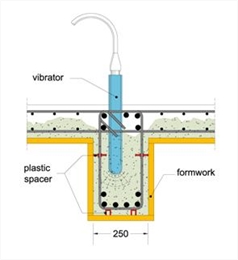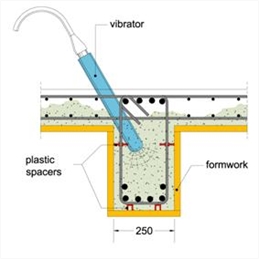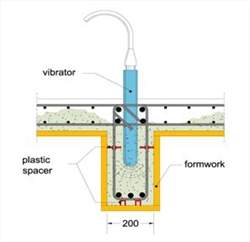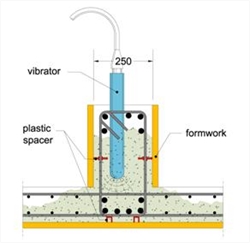|
« Beam under torsion
Slabs »
|
The feasibility of concrete casting in beams In the construction of a building, the proper reinforcement implementation will be proved only during the concreting process. The reinforcement installation must always allow for the concrete and vibrator to pass unobstructed between rebars. In case of the columns, the beams and the slabs of one storey are simultaneously cast, the reinforcement implementation requires even more attention and care. Since the concreting correlates with proper construction, it is recommended to complete the concrete casting of a floor in two phases. The first phase should include the mould and the concreting of the columns and the second phase should include the mould and the concreting of the beams and the slabs. The key to a feasible concrete casting is the use of a second rebar layer, as described in paragraph 3.4.2. Placing the bars at the two edges of that second layer is not a strenuous procedure since they are wired together with the stirrup legs. That way, enough space is provided for the concrete and even for the vibrator to pass vertically between the rebars. As a rule, in earthquake resistant structures there is a large amount of reinforcement and if its implementation is not done in the proper way, most of the times, the following serious constructional faults appear in the joint areas: (a) In case the columns, the beams and the slabs of one storey are simultaneously casted, small or large voids appear inside the columns’ concrete mass which are extremely difficult to fill. (b) In case columns are casted separately from the other elements, concrete does not pass under the rebars so as to bond with the already casted column. The worst part is that this fault cannot be seen by the eye as the concrete passes normally through the cover depth. Unfortunately, it is only until after the formwork’s removal that one may realize if this is properly constructed. The following figures present 5 rules for the proper reinforcement implementation and the proper concrete casting:  The vertical vibration is the most desirable one. (1)
The vertical vibration is the most desirable one. (1) The vertical vibration is the most desirable one. (1)  In the presence of a slab, an alternative vibration possibility is the lateral placement of the device. (2)
In the presence of a slab, an alternative vibration possibility is the lateral placement of the device. (2) In the presence of a slab, an alternative vibration possibility is the lateral placement of the device. (2)  The 200 mm wide beam should be avoided. However, when it is constructed it requires great care. (3)
The 200 mm wide beam should be avoided. However, when it is constructed it requires great care. (3) The 200 mm wide beam should be avoided. However, when it is constructed it requires great care. (3)  The only way to vibrate an inverted beam is by vertically positioning the device. (4)
The only way to vibrate an inverted beam is by vertically positioning the device. (4)
The only way to vibrate an inverted beam is by vertically positioning the device. (4)
In the case where the beam is not connected on either side with a slab (foundation beams), the only way to vibrate the concrete is by the vertical placement of the device. (5)
|
« Beam under torsion
Slabs »
|

|